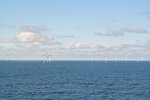11/09/2004
Wind farms to rescue Hong Kong from toxic soup of smog?
Industrialization is giving the administration of Hong Kong a headache and it is therefore looking for technology to resolve it. Hong Kong has been shrouded in a cloud of smog for months and calls from green leaders have grown louder. The heavily industrialized Pearl River Delta region across the border, and particularly its ageing, smoke-belching power stations, are believed to be the source of some 90 % of the toxic soup that engulfs Hong Kong on most days. But energy experts say that within this soot-blackened region is an oasis of environmentally friendly wind-power turbines that could point the way to a cleaner future for the former British colony.
In order to improve local air quality and as an attempt to conserve the rapidly shrinking supplies of worldwide energy sources, the Hong Kong government is considering ways and means of phasing out the burning of fossil fuels, such as coal, oil and natural gas to produce power for its 6.8 million people. It has begun seeking public opinion about the development of cleaner and renewable energy sources and last week it led a fact-finding tour of a 'wind farm' in the coastal town of Shanwei, one of three such installations in neighboring Guangdong province in southern China.
The farm consists of 25 wind turbines built over two years that generate approx. 33,000 megawatts of electricity annually, enough to keep 9,000 Hong Kong households running for a year. A further 24 turbines are expected to be built next year. Hong Kong is planning to produce just 1 % of its electricity needs from renewable energy by 2012, 2 % by 2017 and 3 % by 2022. But the Hong Kong government argues that the main obstacle to the fast development of large-scale wind power plants is a lack of space in one of the world's most densely populated cities and the unlikelihood of it making a suitable return on investment. 'Wind farms take up a lot of room so that is a big problem in Hong Kong,' said Mr Otto Poon, convenor of Renewable Energy Support Group, part of the government's Council for Sustainable Development. The group estimates that solar panels and wind turbines needed to power the city would take up some 40 % of the scarce land and sea areas of the territory.
In order to improve local air quality and as an attempt to conserve the rapidly shrinking supplies of worldwide energy sources, the Hong Kong government is considering ways and means of phasing out the burning of fossil fuels, such as coal, oil and natural gas to produce power for its 6.8 million people. It has begun seeking public opinion about the development of cleaner and renewable energy sources and last week it led a fact-finding tour of a 'wind farm' in the coastal town of Shanwei, one of three such installations in neighboring Guangdong province in southern China.
The farm consists of 25 wind turbines built over two years that generate approx. 33,000 megawatts of electricity annually, enough to keep 9,000 Hong Kong households running for a year. A further 24 turbines are expected to be built next year. Hong Kong is planning to produce just 1 % of its electricity needs from renewable energy by 2012, 2 % by 2017 and 3 % by 2022. But the Hong Kong government argues that the main obstacle to the fast development of large-scale wind power plants is a lack of space in one of the world's most densely populated cities and the unlikelihood of it making a suitable return on investment. 'Wind farms take up a lot of room so that is a big problem in Hong Kong,' said Mr Otto Poon, convenor of Renewable Energy Support Group, part of the government's Council for Sustainable Development. The group estimates that solar panels and wind turbines needed to power the city would take up some 40 % of the scarce land and sea areas of the territory.
- Source:
- Online editorial www.windfair.net
- Author:
- Trevor Sievert, Online Editorial Journalist
- Email:
- press@windfair.net
- Keywords:
- Hong Kong, China, wind energy, wind turbine, wind farm, renewable energy, onshore, offshore

























